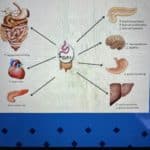I’m sorry it’s been so long since I’ve posted a blog. Besides being busy at work and moving out of one house and into another, I also got slammed by a retinal detachment two weeks ago that required emergency repair. Fortunately, despite being forced to lie on my right side for 10 days under threat of a failed surgery and potential blindness, I survived this sentence and now can type sitting upright.
There is lots to be written but it does not have to be done today. I did read a lot and found some very interesting fitness-related material I could share, but that’d be ex post facto now, so let’s move on to today.
In the above link, the hypothesis is that we have an ‘activitystat’ much like a thermostat that keeps our bodies at a set level – of activity, in this case. Studies have shown that kids in varying amounts of school-based p.e. are not stimulated to be more active as a result of their school behavior. That is, if you are in p.e. class x-hrs/wk, you are not apt to be more active outside of school than kids who are not given similar opportunities to be moving around. In fact, they find that most kids move about the same numbers of hours/wk regardless of how many hours of p.e. they have in school. As such, the hypothesis is we have a set point of hours of activity and, if we move a lot today, tomorrow we’ll move less; and if we don’t move in school, we’ll be more inclined to move after school.
I don’t buy it, and there is other literature that supports this counter-belief. I say belief because (1) I’ve not done nor read much research in this arena and (2) I think our activitystats are all screwed up by our environments. My proof? ME! audacious, yes, but let me explain.
My life is pretty active. I train clients moving about the gym anywhere’s from 5-13 sessions/day, or 5-12 hrs. (the days I do 13 I also have some half hr sessions.) When I get home, I don’t sit around more or less depending on my sessions that day. In fact, as I’ve written before, I often get on the exercise bike or ski machine later in the evening before bedtime in order to get some activity that I’d call exercise. Now, sure, I’m an exercise professional for whom it’s a lifestyle. If set point theory was right, i’d be more apt to chill on long days and more apt to exercise longer on short ones. Again, a study of one is insufficient to argue one way or the other but I have more to tell you that may be more scientifically valid.
While laid low, I had no appetite. despite shopping with my girlfriend – Cherrie – and staying at her house under her watchful eyes for those 10 days, I could not find any foods or junky foods that appealed to my tastes. Not unusual here; illness and injury often disrupt normal taste for food. I proceeded to lose 5# lying still allllll day long. Most would gain wt. I lost – mostly muscle mass. This past monday, when the doc 
So what happened? Why didn’t i gain? How is it I’ve regained? It’s really quite simple.
As a lean, muscular person who’s been this way my entire pre-adult and adult life, my body is ‘set’ to such a degree that it eats what it expends and vice versa. When I trained in martial arts 3-5 hrs/d, and did construction work, and a few miles of running, I ate like a horse. When I gave up the construction work and scaled the tae kwon do to teaching, I ate less. When I could not exercise as hard due to bad joints and had even stopped teaching, I ate even less. When I was laid up and not able to do any activity, I hardly ate at all. The hormonal stimuli that otherwise told me to eat had scaled itself down to where it was telling me I hardly had to eat any more.
Now this differs from the homeostatic mechanisms of most, esp the obese and sedentary. Most folks, sentenced to supine-ness, would have eaten as normal and gained weight, mostly fat. We know, interestingly, that leptin, a brain hormone that’s linked to appetite via fat stores and intake, is less effective in the obese than in normal weight people. In other words, they have leptin insensitivity. Interestingly, when they diet and lose weight, leptin continues to stimulate appetite to a greater degree than when they exercise to lose weight. In both cases, leptin decreases but with exercise, due to the increased sensitivity to it, it actually requires less in order to be more effective at modulating appetite according to the new weight.
The message here is, as a lean, active person, I’m regulated toward leanness, even when inactive. It’s a pretty tight setting under which I operate. The overwt/obese may not have such tight settings – we don’t know which comes first tho genomics is looking hard at this – and so are apt to eat even when not burning calories, or even after eating. and I suspect the same is true for activity: lean, active people are active, more than their overwt/obese peers, even if they’ve been encouraged or forced to be active by outside or internal mechanisms, and it has little to do with how active they had been earlier. In other words, without assigning guilt – as it could be genetics for some – those who are carrying too much weight have set their thermostats to lower settings such that they may indeed reduce later activity if they had some earlier. It may be that our culture and environment simply does not mandate enough activity to re-set their activitystats because, in days of yore, before electricity and other modern conveniences, if they didn’t move, they didn’t eat. It’s the lifestyle, not the genetics, that determines movability!
go to: http://well.blogs.nytimes.com/2011/10/19/do-we-have-a-set-point-for-exer…














